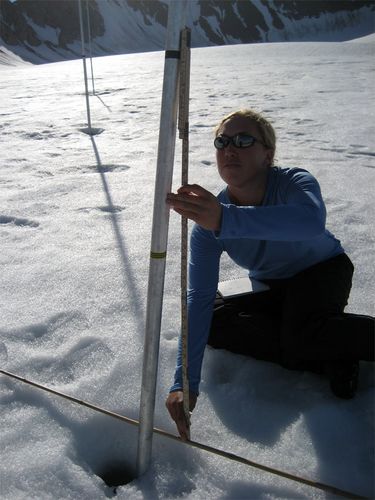As mentioned in a former journal entry, the weather here is very changeable. For instance today we walked out to Lake Linne wearing light clothing since the sun was shining and the crisp air was still. Our clothing choices were great for a good part of the day; up until about 3PM when the wind started. We have no idea who invited the 20mph headwind to our nice day on the glacier, but we had no choice but to deal with it for our entire trek back to the station! Fortunately the wind was only wind and not an icy cold precipitation event which would have been more of a challenge to deal with. In regards to clothing for wind like this, Gore-Tex really is the key to keeping the drafts from sneaking into our under layers. As far the effects of the wind on completing our tasks for the day, it only affected the team up at Lake Kongress who needed to be on a steady boat to test an acoustic profiler. Kristen, Jesse and I ventured up to the Linne Glacier to take measurements for Kristen's project studying the relationship between glacial ablation and daily weather parameters. The hike out to Lake Linne is 5km, the hike from the south end of Lake Linne to the glacier is 6km, and the hike up the glacier is 2.5km. The round trip from Isfjord Radio is 27km (15+miles), half of which was in the headwind! Kristen has been making this trek every other day since July 23rd when she started collecting data. There are a few stops that break up the day including a stop to change from hiking boots to Muck boots, a stop for lunch and to measure stream discharge, and a stop at each of these places on the way back down the glacier.
 Kristen is measuring stream discharge. Note the Linne Glacier in the background
Kristen is measuring stream discharge. Note the Linne Glacier in the background
Kristen is studying what is called glacial ablation which is loss of snow and ice on the glacier. She does this by making measurements on glacial ablation stakes that are placed up the glacier and also measures snow depth. In regards to what the glacier looks like from bottom to top, it starts out as ice and eventually there is a "snow line" transition where quite a bit of the snowpack on top of the ice. She is also curious about how this melting affects stream discharge at a location close to the front of the glacier. To measure this she dons a dry suit and gets into the meltwater stream to measure stream depth and velocity. Back at the station she will combine these values to determine the stream discharge on the days when she measures glacial ablation. There is a weather station on the glacier that is measuring incoming solar radiation (insolation), precipitation with a rain bucket, and temperature. Kristen will use this data along with her glacial ablation values and stream discharge to gain an understanding of how all these factors are related. She also plans to compare the data from this year to data from past years to see the changes in the Linne glacier over time. Kristen was surprised in the tremendous amount of snowpack loss (20 cm) at the onset of data collection, and then she found the loss to level off between July 25th and 27th. Also of note is that the Linne Glacier has retained more snow this year than in the recent past. This may be attributed to the fact that it was a snowy year in Longyearbyen.
 A meter stick is used to measure changes in glacial ablation (snow loss and ice melt). Note the yellow tape on the pole. This was the depth of the snow and ice on July 23, 2008.
A meter stick is used to measure changes in glacial ablation (snow loss and ice melt). Note the yellow tape on the pole. This was the depth of the snow and ice on July 23, 2008.
 This weather station gathers data automatically and is powered by large car-type battery.
This weather station gathers data automatically and is powered by large car-type battery.
 There is quite a distance from where this picture was taken and the back wall of the cirque.
There is quite a distance from where this picture was taken and the back wall of the cirque.
Question of the day: What is "albedo" and how does it vary from surface to surface? What does this mean for the absorption and reflection of solar radiation?

